
|

|
Supernatural Beings in Norse Society
 It's
a bit hard to describe a Norseman's view of the supernatural beings existing in
his world. When Icelanders did write down stories about the supernatural, it was
already more than a century after the conversion to Christianity. So it became
necessary to put those stories in terms that would be acceptable to the
Christian hierarchy, altering the relationships between these beings.
It's
a bit hard to describe a Norseman's view of the supernatural beings existing in
his world. When Icelanders did write down stories about the supernatural, it was
already more than a century after the conversion to Christianity. So it became
necessary to put those stories in terms that would be acceptable to the
Christian hierarchy, altering the relationships between these beings.
The Norse stories tell about the ongoing struggle between the gods (the Æsir and the Vanir) on one hand, and the jötnar on the other. The Norse word "jötnar" is usually translated as "giant", but that probably doesn't fully express the Norse view of these beings.
The stories show that the struggle between the gods and the giants is ceaseless, such as the battles between Þór and Hrungnir, and between Óðin and Suttung, for example. Yet the Æsir are descended from giants: the giantess Bestla was the mother of Óðin and his brothers, the first of the Æsir. Gods seek the daughters of giants to be their brides, such as Freyr and Gerð. And many of the cultural treasures of the gods come from the giants, such as the mead of poetry.
Perhaps the Æsir, the Vanir, and the jötnar can be thought of as separate tribes. And perhaps, like the Vanir, the jötnar represent the gods of some earlier cult that struggled with those who worshipped the Æsir.
To Norsemen, the Æsir and Vanir seem not to be feared deities, but rather close associates, friends, or even family members - distantly related family, but family none the less. One felt comfortable asking these entities for favors. Nor did one feel uncomfortable about cursing or abusing them if favor was withheld. The Æsir and Vanir were powerful, and not to be trifled with, but one could be familiar, informal, and comfortable with them.
Other supernatural beings in the Norse world include:
Álfar (elves) are close confederates of the gods. In the story of creation, the elves and the gods are linked, as if the elves were only one step lower than the Æsir. The light elves live in a splendid place called Álfheim, while the dark elves live underground. A frequent refrain in poetry is "How fare the Æsir? How fare the elves?", a beautifully alliterative couplet in old Norse. While sacrifices to the elves (álfablót) are mentioned in the sagas (for instance, chapter 22 of Kormáks saga) the elves seem to be less important at the time of the sagas than they had been earlier. Elves are hard to deal with, rewarding generously, but attacking cruelly. |
 |
Dvergar (dwarves) are wise and skilled in crafts. Dwarves made the treasures of the gods (such as Þór's hammer), and they are the repository of secret wisdom. They live among the rocks away from light, because sunlight causes them to turn to stone. There is no evidence that the dwarves were worshipped, but men were wary of them and took care not to offend them. |
 |
Jötnar (giants) live outside the land of men (Miðgarðr) and the land of gods (Ásgarðr). The world was created from a giant, and the first Norse gods were mothered by a giant. The gods seduce and marry the daughters of giants, and giants try to win the hands of goddesses, but never successfully. Yet, giants are fearsome and threatening, both to men and to gods. Þórr spends much of his time battling giants. The door ring on the church at Haukadalur is made from the ring of a giant (right). |
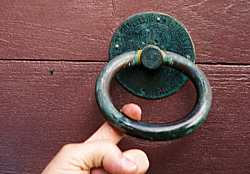 |
Draugar are the ghosts of dead people. Some dead people, not content to lie in their grave mounds, live on after death. Usually, these are people who committed an evil deed during their life. The ghosts return to harass the living, causing illness, insanity, and death. Chapter 34 of Eyrbyggja saga tells of Þórólfr bægifótr (twist-foot), an early settler in the region. When he died, he was buried on a ridge in the mountains above the fjord. However, he did not lie quietly in his grave, and his ghost terrified the local farmers, killing sheep and shepherds. Þórólf's son dug up the body and moved it to a headland overlooking the fjord (right), out of view of all the farms. He reburied the body, and then built a high wall separating the headland from the mainland. |
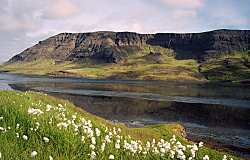 |
Dísir are female spirits attached to a particular family. Like Freyja, with whom they are associated, the dísir have power over the forces that bring nature's bounty to mankind. They visit the homes of new-born children to bring good luck. There is evidence that sacrifices to the dísir (dísablót) occurred at the beginning of winter during the Norse era. While they are normally well disposed towards mankind, the dísir can be merciless. Þiðranda þáttr og Þórhalls tells how Þiðrandi was attacked and killed by dísir at a time when his family was planning to convert to Christianity. |
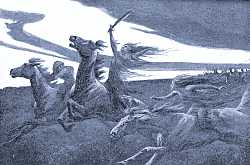 |
Landvættir are land spirits on whom the prosperity of the land depends. They live in the land, usually in particularly attractive rocks and boulders. Spirits are believed to live in the rock Grímsborg (right) in the homefield at Keta in Iceland. Not only in the Norse era, but even today in Iceland, the landvættir are treated with respect. Old Icelandic law (Landnámabók H.268) required that approaching ships must remove their dragon-head prows so as not to frighten the landvættir. |
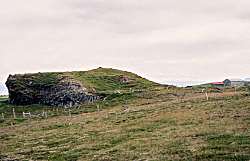 |
Fylgjur are personal guardian spirits in the shape of an animal. A fylgja follows its human and prevents danger and accidents. When seeing a guest out, it is a tradition to follow him out the door, giving the guest's fylgja, if it should still be in the house, a chance to catch up to its human. By banging on a door or wall, the fylgja may notify its human of a friend's arrival, or of an accident about to happen. When a fylgja shows itself, it is most commonly in the shape of an animal. A fearless man might have a brave animal, such as a bear, as a fylgja, while a fearful person might have a hare or bird. Seeing one's own fylgja is a sign that death is close at hand. |
 |
Troll is another name for a giant. It wasn't until later in the medieval era, well after the Norse era had drawn to a close, that trolls became beings in their own right. Like dwarves, trolls turned to stone when struck by sunlight. The troll woman (Kerling) shown to the right is in Drangsnes in west Iceland and was turned to stone as the sun came over the Malarhorn ridge. |
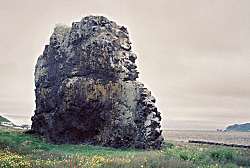 |
Valkyrja is a female warrior, one of Óðin's handmaidens who chooses the warriors who are to fall in battle. They are present on the battlefield to make the "choice", and they are present in Valhöll where the fallen warriors gather. |
 |
|
A video presentation on The Walking Dead in the Sagas: Zombies of the Viking Age by Dr. William R. Short, manager of Hurstwic, LLC. The lecture discusses some of the supernatural creatures of the Viking age and later, and was part of the Hurstwic Heathen study group series of presentations and discussions. |
|
|
©1999-2025 William R. Short |